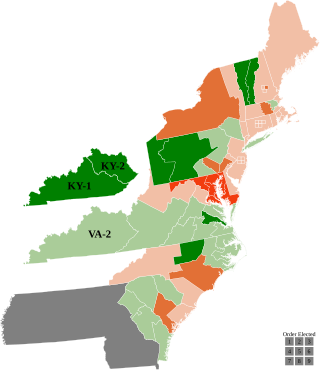
The 1792–93 United States House of Representatives elections were held on various dates in various states between August 27, 1792, and September 6, 1793. Each state set its own date for its elections to the House of Representatives before the first session of the 3rd United States Congress convened on December 2, 1793. With the addition of the new state of Kentucky's representatives, and the congressional reapportionment based on the 1790 United States census, the size of the House increased to 105 seats.

The 1790–91 United States House of Representatives elections were held on various dates in various states between April 27, 1790, and October 11, 1791. Each state set its own date for its elections to the House of Representatives before or after the first session of the 2nd United States Congress convened on October 24, 1791. This was the first midterm election cycle, which took place in the middle of President George Washington's first term. The size of the House increased to 67 seats after the new state of Vermont elected its first representatives.

Elections in Vermont are authorized under Chapter II of the Vermont State Constitution, articles 43–49, which establishes elections for the state level officers, cabinet, and legislature. Articles 50–53 establish the election of county-level officers.

The 2008 United States presidential election in Vermont took place on November 4, 2008, concurrent with the federal election in all 50 states and D.C., which was part of the 2008 United States presidential election. Voters chose three representatives, or electors to the Electoral College, who voted for president and vice president.

Vermont was admitted at the end of the First Congress, with the admission taking effect at the start of the Second Congress. Vermont was entitled to elect two representatives. Vermont law at the time required a majority to win an office. In the 1st district, no candidate won a majority, necessitating a run-off.

Due to Vermont's election law requiring a majority to secure a congressional seat, the 1st district required three ballots to choose a winner.

Vermont increased its apportionment from 2 seats to 4 after the 1800 census. Vermont law at the time required a majority of votes to win an office, which frequently necessitated additional ballots.

Vermont elected its members On September 1, 1818.

Vermont law required a majority for election, which frequently mandated runoff elections. The 2nd, and 3rd districts both required second elections in this election cycle, and the 3rd district required a third election.

Vermont elected its members November 4, 1810.

Vermont had no apportionment in the House of Representatives before 1790 census because it was not admitted to the Union until 1791. Vermont's election laws at the time required a majority to win election to the House of Representatives. If no candidate won a majority, a runoff election was held, which happened in the 1st district.

Majority vote required to win, necessitating a run-off election in the 1st (Western) district.

Vermont elected its members September 2, 1806.

The 2018 Vermont gubernatorial election took place on November 6, 2018, to elect the governor of Vermont, concurrently with the election of Vermont's Class I U.S. Senate seat, as well as other elections to the United States Senate in other states and elections to the United States House of Representatives and various state and local elections. Incumbent Republican governor Phil Scott, who was first elected in 2016, was re-elected to a second term in office. Hallquist's 40.3% was also the worst performance for a Democratic Party candidate since 2008. This was one of eight Republican-held governorships up for election in a state that Hillary Clinton won in the 2016 presidential election.

The 1896 United States presidential election in Vermont took place on November 3, 1896, as part of the 1896 United States presidential election. Voters chose four representatives, or electors to the Electoral College, who voted for president and vice president.

Only one of the two Vermont incumbents was re-elected.

The 2022 Vermont gubernatorial election was held on November 8, 2022, to elect the governor of Vermont. Incumbent Republican governor Phil Scott won re-election to a fourth term in a landslide, defeating Democratic nominee Brenda Siegel.

The 2020 Vermont House of Representatives elections took place as part of the biennial United States elections. Vermont voters elected all 150 state representatives from 104 districts, with each district electing between one and two representatives. State representatives serve two-year terms in the Vermont House of Representatives. A primary election on August 11, 2020, determined which candidates appeared on the November 3 general election ballot. All the members elected will serve in the Vermont General Assembly.

The 2020 Vermont Senate elections took place as part of the biennial United States elections. Vermont voters elected all 30 state senators from 13 districts, with each district electing between one and six senators. State senators serve two-year terms in the Vermont Senate. A primary election on August 11, 2020, determined which candidates appeared on the November 3 general election ballot. All the members elected would serve in the Vermont General Assembly.

The 2022 Vermont House of Representatives election took place on November 8, 2022, as part of the biennial United States elections. The election coincided with elections for other offices including the U.S. Senate, U.S. House, Governor, and State Senate. Vermont voters elected all 150 state representatives from 109 districts, with each district electing between one and two representatives. State representatives served two-year terms. A primary election was held on August 9, 2022, and it determined which candidates appear on the November 8 general election ballot. All the members elected would serve in the Vermont General Assembly. This election was the first to use new districts adopted by the Vermont General Assembly to allocate for population changes across the state after the 2020 census.











